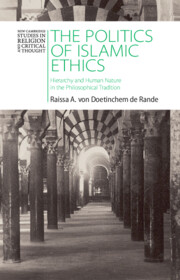Refine search
Actions for selected content:
231 results
6 - Remote Working and Subordination
-
-
- Book:
- Remote Work and Labor Institutions
- Published online:
- 12 December 2025
- Print publication:
- 22 January 2026, pp 98-115
-
- Chapter
-
- You have access
- Open access
- HTML
- Export citation
5 - Neurobiological Reduction
-
- Book:
- Explanation and Critical Thinking in the Neurosciences
- Published online:
- 17 December 2025
- Print publication:
- 22 January 2026, pp 109-130
-
- Chapter
- Export citation
1 - Changing Approaches to Interference in the Global South
-
- Book:
- New Regional Authorities
- Published online:
- 17 December 2025
- Print publication:
- 08 January 2026, pp 1-32
-
- Chapter
- Export citation

New Regional Authorities
- Self-Determination and the Global South
-
- Published online:
- 17 December 2025
- Print publication:
- 08 January 2026
Chapter 3 - The Hybris of the Downtrodden
- from Part I - Hybris in Classical Greece
-
-
- Book:
- Hubris, Ancient and Modern
- Print publication:
- 04 December 2025, pp 69-87
-
- Chapter
- Export citation
16 - Conclusion: A Newly Dynamic East Asian International Order
- from Part V - Conclusion
-
-
- Book:
- East Asia and the Modern International Order
- Published online:
- 25 November 2025
- Print publication:
- 20 November 2025, pp 299-320
-
- Chapter
- Export citation
Case 22
-
- Book:
- Debating Papal History, c. 250–c. 1300
- Published online:
- 03 November 2025
- Print publication:
- 20 November 2025, pp 213-218
-
- Chapter
- Export citation

Universal Biology
- The Physics of Life through the Macro-Micro Consistency Principle
-
- Published online:
- 11 November 2025
- Print publication:
- 20 November 2025

Ancient Assyrians
- Identity and Society in Antiquity and Beyond
-
- Published online:
- 09 October 2025
- Print publication:
- 23 October 2025
2 - The International Politics of State-Building
-
- Book:
- Hierarchy and the State
- Published online:
- 20 August 2025
- Print publication:
- 02 October 2025, pp 23-40
-
- Chapter
- Export citation
1 - The United States and International State-Building Efforts
-
- Book:
- Hierarchy and the State
- Published online:
- 20 August 2025
- Print publication:
- 02 October 2025, pp 1-22
-
- Chapter
- Export citation
13 - Predator
- from Part Three - Tenure’s Labor
-
- Book:
- The War on Tenure
- Published online:
- 30 September 2025
- Print publication:
- 30 September 2025, pp 112-118
-
- Chapter
- Export citation
Chapter 1 - Introduction
-
- Book:
- Performing Justice in the Later Roman Empire
- Published online:
- 07 August 2025
- Print publication:
- 21 August 2025, pp 1-25
-
- Chapter
- Export citation
The middling of international hierarchies
-
- Journal:
- Review of International Studies , First View
- Published online by Cambridge University Press:
- 15 August 2025, pp. 1-18
-
- Article
-
- You have access
- Open access
- HTML
- Export citation
2 - The Promise of Non-Recurrence
-
- Book:
- Governing the Past
- Published online:
- 30 July 2025
- Print publication:
- 07 August 2025, pp 35-64
-
- Chapter
- Export citation
4 - ‘If We Do Not Talk About These Issues Now …’
-
- Book:
- Governing the Past
- Published online:
- 30 July 2025
- Print publication:
- 07 August 2025, pp 95-123
-
- Chapter
- Export citation
11 - Key Principles of International Law and Hierarchy of Rights Holding
- from Part IV - Construction of Legitimacy in International Law
-
- Book:
- The Law and Politics of International Legitimacy
- Published online:
- 14 July 2025
- Print publication:
- 24 July 2025, pp 202-225
-
- Chapter
- Export citation
7 - Should Innovation Be Managed?
-
- Book:
- Innovation Management
- Published online:
- 06 June 2025
- Print publication:
- 10 July 2025, pp 91-109
-
- Chapter
- Export citation
Conclusion
-
- Book:
- The Politics of Islamic Ethics
- Published online:
- 29 June 2025
- Print publication:
- 10 July 2025, pp 256-281
-
- Chapter
- Export citation

The Politics of Islamic Ethics
- Hierarchy and Human Nature in the Philosophical Tradition
-
- Published online:
- 29 June 2025
- Print publication:
- 10 July 2025
